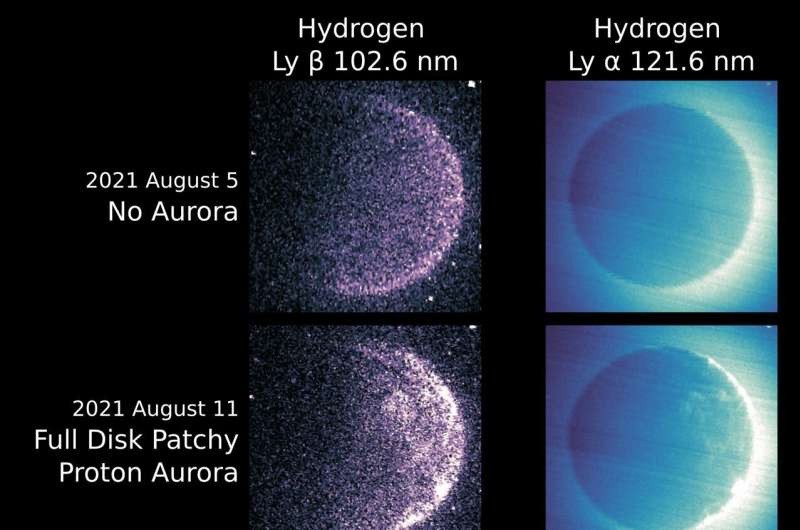The United Arab Emirates' Emirates Mars Mission (EMM) and NASA's MAVEN (Mars Atmosphere and Volatile Evolution) mission both made observations of the proton aurora on Mars. It turns out that the aurora above the Martian atmosphere can become patchy.
This partnership, which shows the utility of multi-point observations in space, was made feasible by a recent data exchange between the two missions. Geophysical Research Letters recently published the results of these observations.

Patchy Proton Aurora
In the latest research, EMM found tiny structures in the proton aurora that encompassed the entire dayside of Mars. A type of Martian aurora called a proton aurora was found by MAVEN in 2018; it forms when the solar wind, composed of charged particles from the Sun, interacts with the upper atmosphere.
These auroras are smooth and uniformly dispersed across the hemisphere, according to typical proton aurora observations made by MAVEN and the ESA's Mars Express mission. EMM, on the other hand, saw what looked to be a highly dynamic and varied proton aurora.
Because of Mars' turbulence, charged particles can flood the atmosphere directly and glow when they slow down. This phenomenon is known as "patchy proton aurora", according to NASA.
"EMM's observations suggested that the aurora was so widespread and disorganized that the plasma environment around Mars must have been truly disturbed, to the point that the solar wind was directly impacting the upper atmosphere wherever we observed auroral emission," Mike Chaffin, lead author of the study, said in a statement.
He added that they could verify this theory and conclude that what they were seeing was essentially a map of where the solar wind was showering down upon the planet by integrating EMM auroral observations with MAVEN measurements of the auroral plasma environment.
Unraveling the Mysteries
The bow shock and magnetic fields that encircle the planet usually cause the solar wind to be diverted, making it challenging for it to reach Mars' upper atmosphere.
Therefore, the patchy proton aurora data provide a window into exceptional situations in which the chaotic Mars-solar wind interaction occurs, according to NASA.
Chaffin said that EMM and MAVEN measurements will be crucial in unraveling the mysteries behind these puzzling phenomena.
Multiple viewpoint measurements are useful for studies in heliophysics and Earth science. More than six Mars orbiters are now performing scientific observations since the southern hemisphere of Mars is currently experiencing summer, when proton aurora is believed to be most active.
As a result, multi-vantage-point observations will be crucial to understanding how these events develop.
NASA said that the partnership between EMM and MAVEN exemplifies the significance of discovery-level research into the Martian atmosphere with two spacecraft examining the same location at the same time.
Related Article : 'Largest Canyon in The Solar System:' ESA's Mars Express Snaps Stunning Views of Mars's Grand Canyon
This article is owned by Tech Times
Written by Joaquin Victor Tacla
![Apple Watch Series 10 [GPS 42mm]](https://d.techtimes.com/en/full/453899/apple-watch-series-10-gps-42mm.jpg?w=184&h=103&f=9fb3c2ea2db928c663d1d2eadbcb3e52)



